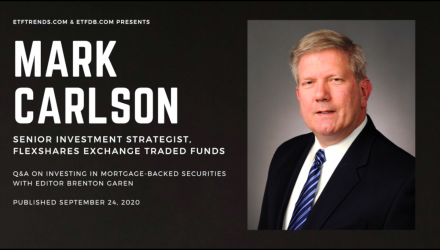ETF Trends caught up with Mark Carlson, Senior Investment Strategist at FlexShares Exchange Traded Funds, to discuss mortgage-backed securities.
Mark, Last week the Federal Reserve reiterated and clarified its policy announcement indicating rates would stay pinned at zero at least through 2023. What implication does this have for the mortgages market?
One implication of decline in interest rates and the return by the Federal Reserve to a sustained zero interest rate policy has been has been a surge in mortgage refinancing as homeowners look to take advantage of low rates.
Prepayment speeds on existing mortgages have accelerated since the initial COVID-19 shock and the MBS market is seeing very high prepayments across the coupon stack and origination years. Prepayment reports from the Agencies on MBS pools from created in 2019 show annualized prepayments rates of over 30% during the month of August. With 10 year and shorter Treasury yields down over 100 bps year over year, it makes perfect economic sense for homeowners to refinance.
Probably the only mitigating factor holding back refinancing activity is that fact that the mortgage origination system is operating at full capacity. The industry is making advancements in using technology and data to speed the process and hiring more personnel, however the fallout from the substandard underwriting and documentation performance during the Credit Bubble, which contributed to the GFC, originating and mortgage service institutions are now making sure to dot every “I” and cross every “T” to avoid any legal fallouts.
These powerful actions in the market have led to a sharp rise in and record surge of MBS supply to the tune of $322 Billion in August alone, a new monthly record.
Despite this record rise, the Federal Reserve and other banks and institutions have absorbed the supply providing support to the asset class.
The Federal Reserve continues to buy MBS in its open market operations- up to $200 billion per month as part of its policy framework to “sustain market functioning and help foster accommodative financial conditions”
Meanwhile- Banks and other institutions holding record amounts of cash and deposits are turning to agency mortgages to earn higher income with quasi government instruments
And he sector is likely to attract more individual investors as the pace of refinancing moderates over time and the attraction of a premium yield over Treasuries proves too hard to ignore
What are some of the concerns investors should be aware of when investing in mortgages/MBS?
The health of the overall housing market right now is something to pay attention to. While broadly the housing market has rebounded from the relative lows reached during the height of the pandemic, many are keeping an eye on potential for additional stimulus and ongoing loan forbearance policies that could support homeowners. But the housing market has been resilient and the amount of loans in forbearance has steadily declined currently sitting at their lowest levels since April.
One of the key risks associated with mortgages that many investors underestimate is prepayment risk and its impact on durations and returns.
As mortgage rates move lower (and at some point in the future, assume they will move higher), prepayment speed assumptions increase (or decrease as rates rise) which lowers effective durations (raises effective durations in raising rate environments). This is known as duration contraction/extension risk. As duration is THE most important factor for predicting returns in fixed income, managing the duration of an investor’s fixed income portfolio is critical.
The current challenge for investors is reinvestment risk, as loans are refinanced at lower rates, prepayments accelerate, and principal is returned to MBS investors who are then facing reinvesting those proceeds at lower current rates and potentially longer durations, lowering their income cash flow stream while potentially adding more interest rate risk to their portfolio.
Given expectations that this ultra-low rate environment will continue for the foreseeable future, how can investors focus on maintaining their income stream?
Agency (Ginnie Mae/Fannie Mae/Freddie Mac) MBS offer an attractive income risk/return solution versus treasuries and short-term corporate credit, offering a premium over the risk free rate for similar credit risk and can be used as a tool to reduce credit risk versus corporates with only a slight reduction in potential yields.
With the 5-year treasury yielding less than 30bps investors can source additional income while taking on marginal amount of credit risk with the MBS yielding on average 135bps.
Investors do need to be mindful of duration risk with their MBS investments. One key difference during this ZIRP environment versus the post-GFC is that the change in Federal Reserve’s approach to the inflation component of its dual mandate. At the September FOMC meeting, the Fed affirmed a policy to allow inflation to “run hot” after periods of under 2%, this means the Fed will be less likely to raise rates in the face of inflation, meaning the yield curve could steepen as investors inflation expectations rise and nominal yields are pushed higher out the curve. This rate movement would have negative total return implications should MBS durations lengthen as the refinancing pace eventually runs out of steam and prepayments slow to more traditional levels
The FlexShares MBSD fund is designed to constrain duration around a 3.75 year duration, with a 50bp upper/lower duration band. MBSD affords investors the greater income potential of MBS while reducing the major risk of duration extension/contraction associated with the changing environment for mortgage prepayments.

